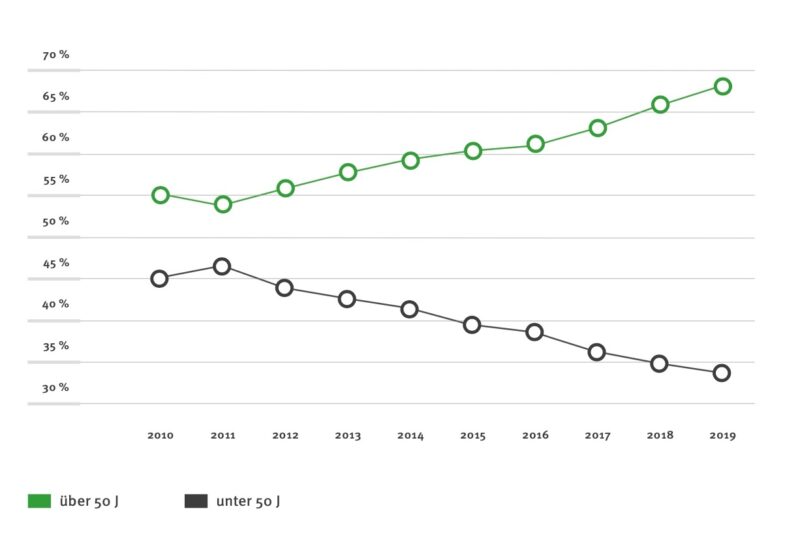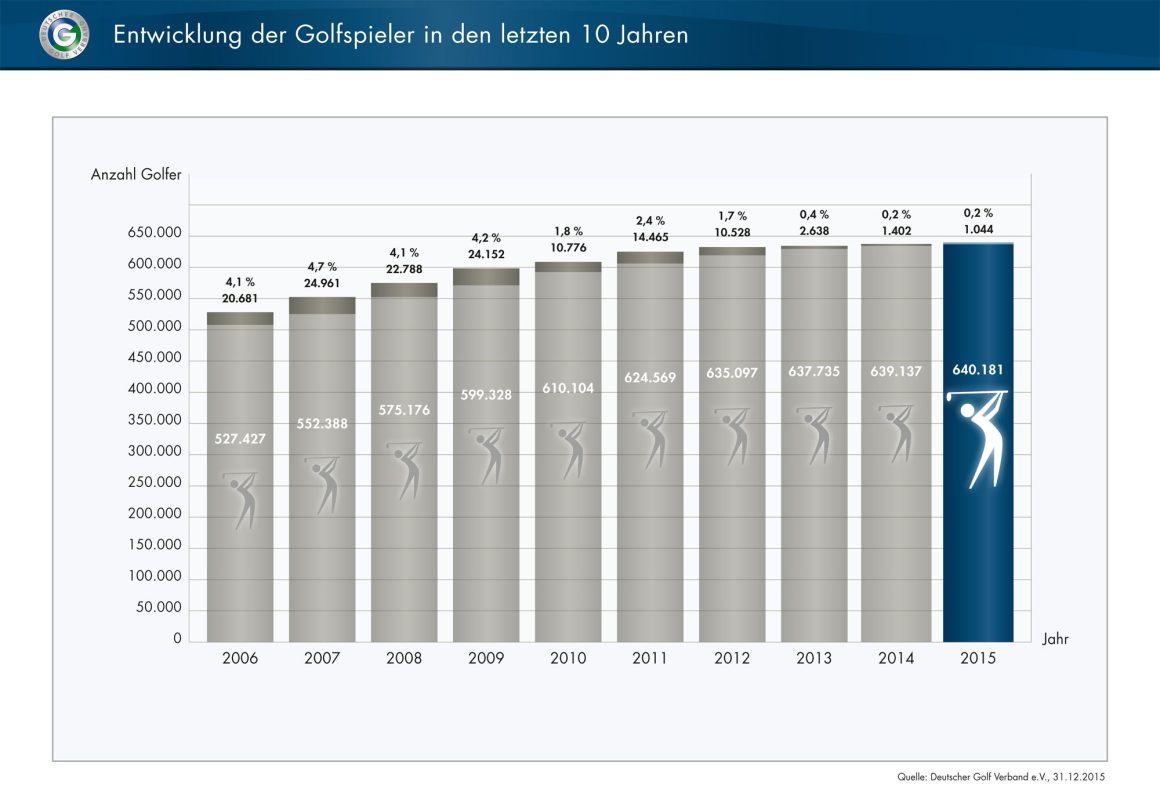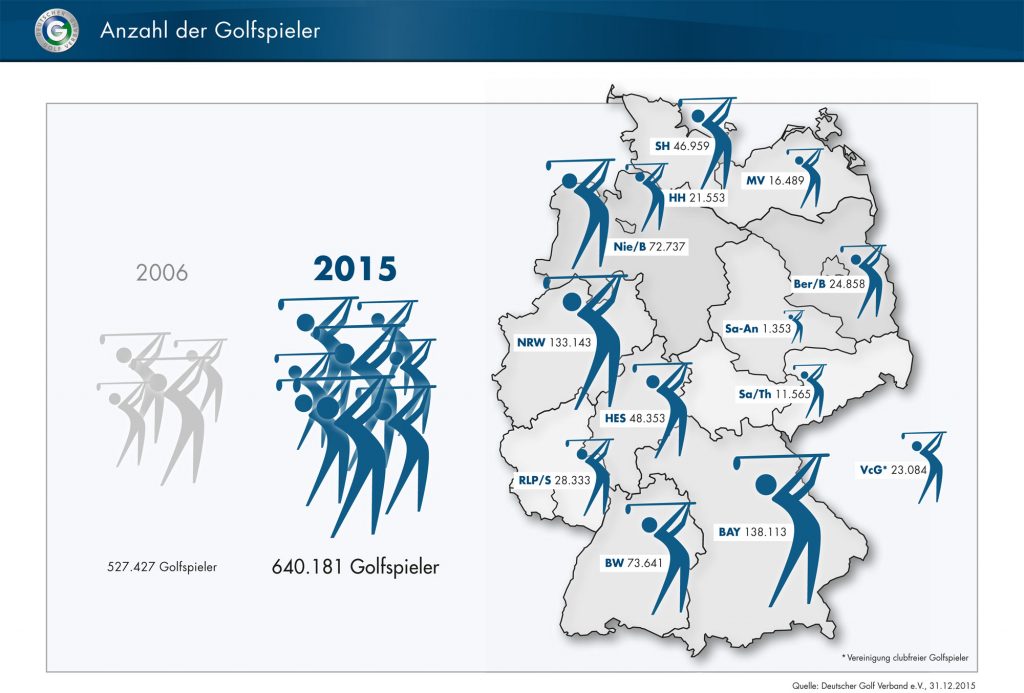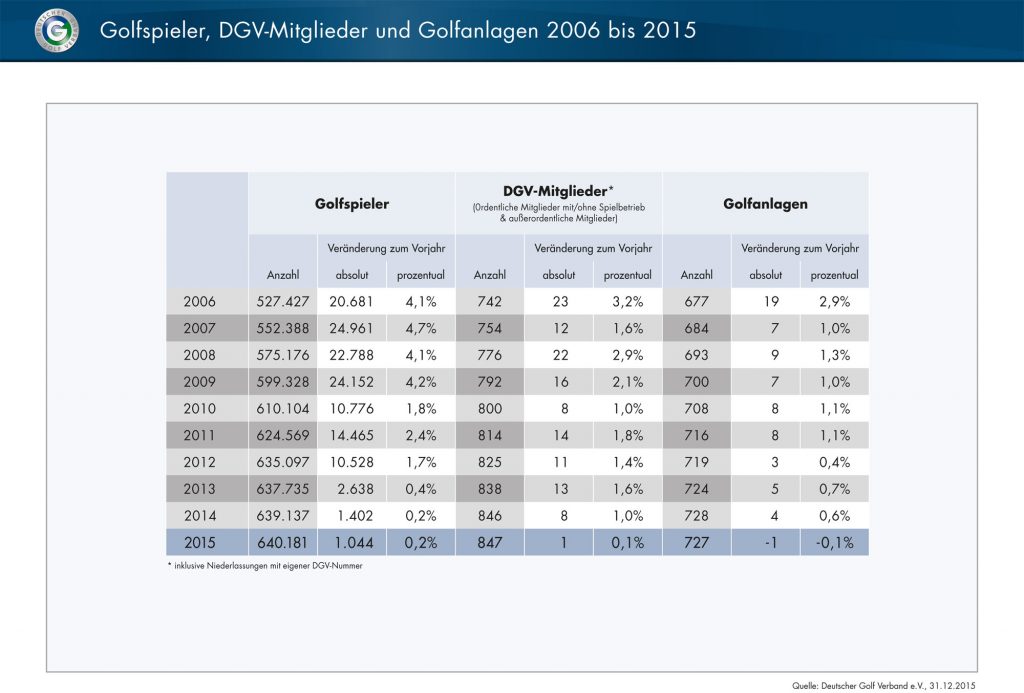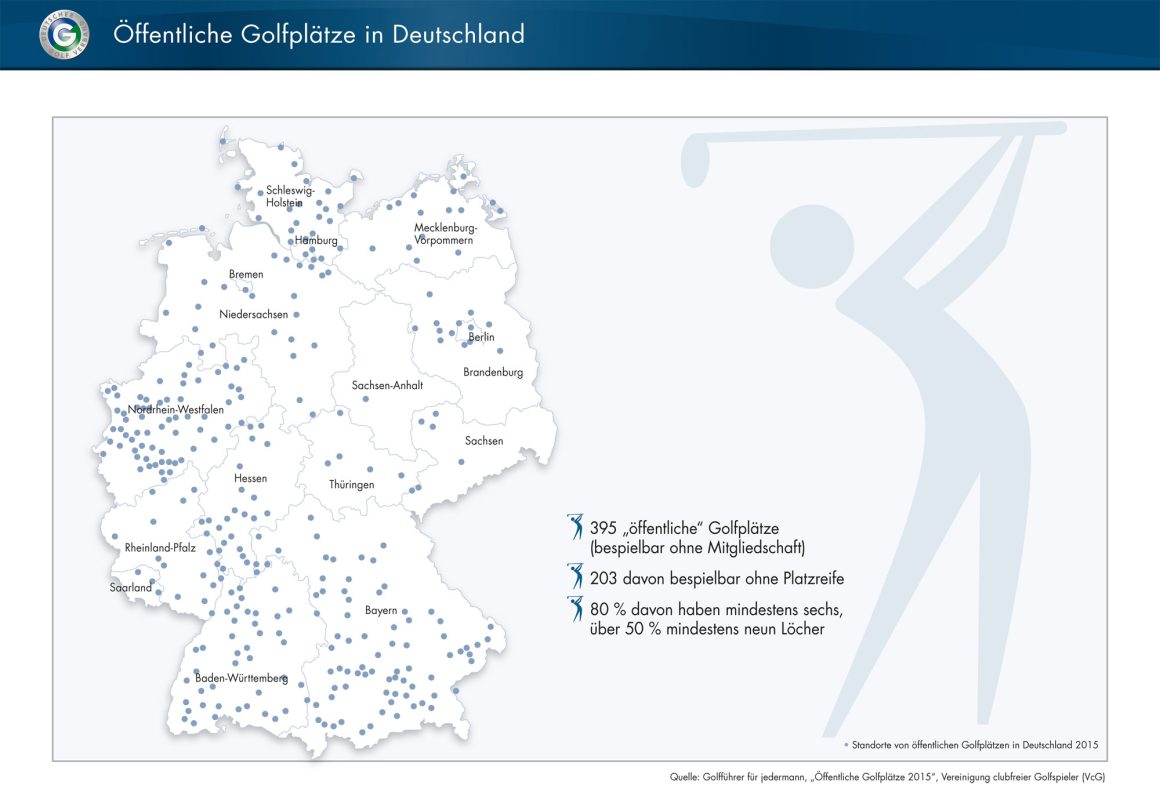Golf has seen a continuous upswing worldwide in recent years. In Germany, it is best to evaluate the figures for organized golfers. These are the golfers who are members and eligible to play in golf clubs and golf courses that are members of the German Golf Association (DGV). In Germany, 682,942 golfers swing a club (as of 2023), while there are now over 80,000 golfers in neighboring Austria. Worldwide there are 60 million. The annual growth in the number of golfers of up to 15% shows that golf is well on the way to becoming a popular sport, at least if you look at the overall figures. But there is still a long way to go before it becomes a “sport for everyone”, at least in Germany.
- According to the European Golf Association, the number of golfers has been declining for several years. In the 44 European countries, 4.44 million people played golf in 2009, compared to 4.26 million in 2013, a decline of 4.0 percent. In England, for example, the number of golfers fell by 11.5 percent in the same period.
- There are 60 million golfers and 35,000 golf coursesworldwide
- The five countries with the most golfers are the USA, Canada, Japan, Great Britain and Australia
- In the USA, with a population of 265 million, there are 25 million golfers (10%)
- In Canada, with a population of 30 million, there are 5 million golfers (17%)
- Out of 8 million Swedes , 500,000 play golf (7%)
- And 80,000 out of 8 million Austrians play golf (1%)
- In Germany, golfers make up 0.66% of the total population
- in2019, the DGV registered a total of 730 golf courses(previous year: 731) with a handicap standard. These have a total of 13,296 holes (previous year 13,305), the majority of which have 18 holes (429 courses), there are 162 9-hole courses and 139 golf courses with 27 holes or more. There are 268 public golf courses, giving Germany a total of 998 golf courses. Details on the distribution of golf courses and their size can be found here.
Golf in Europe 🇪🇺
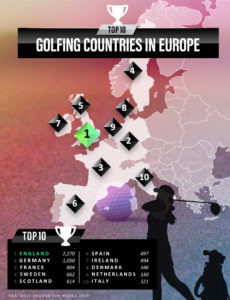
In Europe, Germany certainly qualifies as a golfing country. Measured by the number of golf courses, it even ranks second behind England. There are 2,270 golf courses there, while Germany has slightly less than half that number: 1,050 golf courses. It is followed by France (804), Sweden (662) and Scotland with 614 golf courses.
Spain is in 6th place with 497 golf courses, while Ireland is close behind in 7th place with 494. Denmark (346), the Netherlands (330) and Italy with 321 golf courses round off the top 10 countries with the most golf courses in Europe.
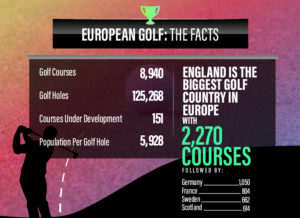
If you look at the countries with the fewest golf courses, they are – also due to their size – Bosnia and Herzegovina (2), Serbia (2), Belarus (2), the Faroe Islands (1) and Malta with just one golf course.
And another fact is quite interesting. 78 percent of the world’s golf courses are located in just 10 countries: the United States, Japan, Canada, England, Australia, Germany, France, the Republic of Korea, Sweden and Scotland.
This ranking looks different when you look at the percentage of golfers in the population.
Further details, in particular figures, on the golf market in neighboring European countries can be foundhere in the article “Golf Market Europe.”
Golf providers in Germany 🇩🇪
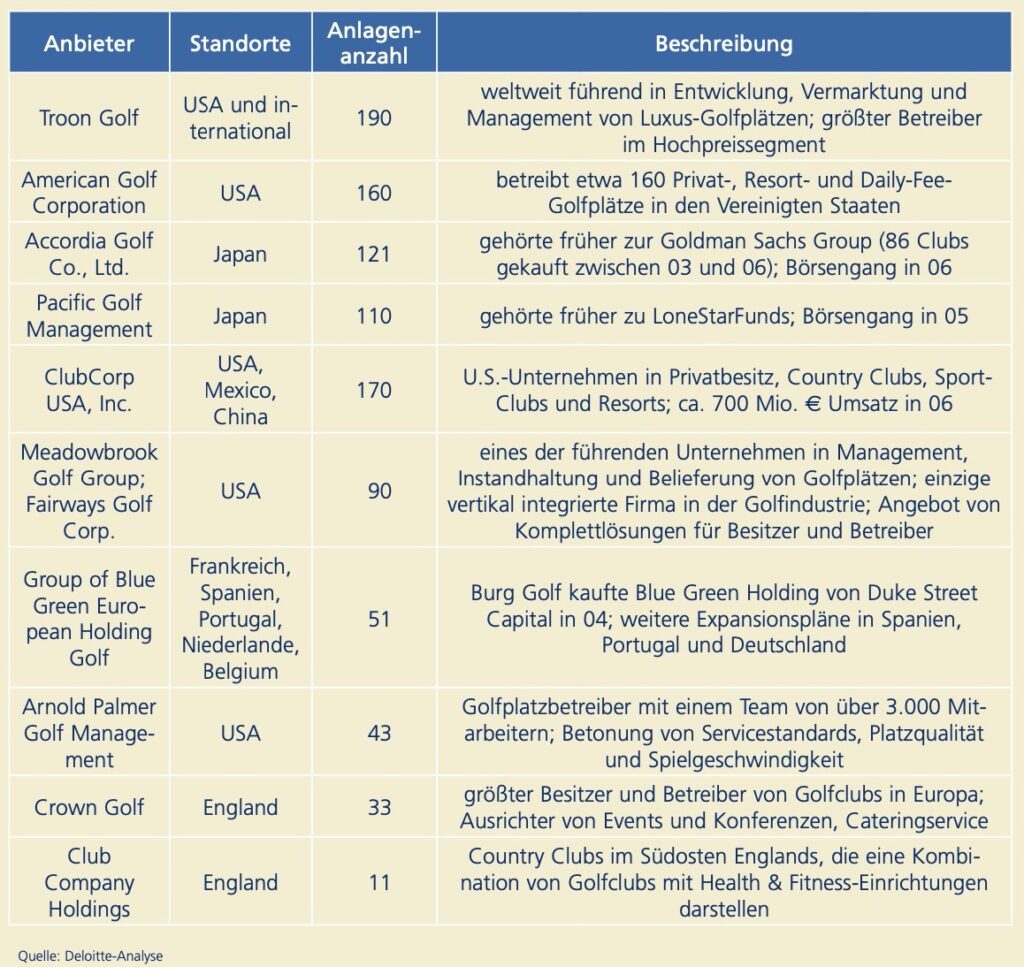
Around half of all golf courses in Germany are run by clubs, while the other half are operated by a commercial enterprise.
Among the companies that operate golf courses, there are some that own several courses. The largest golf providers include Clubhaus AG, with the Schloss Nippenburg golf course and the golf cities in Pulheim and Munich Puchheim, Golf Range GmbH with ten golf courses and over 60,000 customers according to its own figures. The largest provider is “Golfanlagen Weiland GmbH” with 11 golf courses throughout Germany. The company is part of an entire group of companies with a total of around 180 employees and operates under the name “Golf Absolute“. More details on the golf market and the largest golf providers…
More details on the economic situation of golf courses… and the question of what a golf course actually costs.
Number of golf clubs in Germany (since 1951)
In 2022, there were around 800 golf clubs in Germany. The number of clubs increased without exception in the period from 1956 to 2016 and only fell slightly from 2016 to 2017, as the chart shows:
Golf in numbers 2023
The number of golfers registered with the DGV in 2023 was 682,126. Compared to 2022, this is 0.1% less, so the number remained more or less constant. Most of them come from NRW (143,740) and Bavaria (142,968). In 2023, there were 725 golf courses in Germany, compared to 729 in 2022. This means that 4 courses have ceased operations.
Golf in numbers 2022
According to the golf statistics of the German Golf Association, there were a total of 682,942 golfers in Germany in 2022 who were recorded by the association. This is an increase of 1.3 percent compared to 2021.
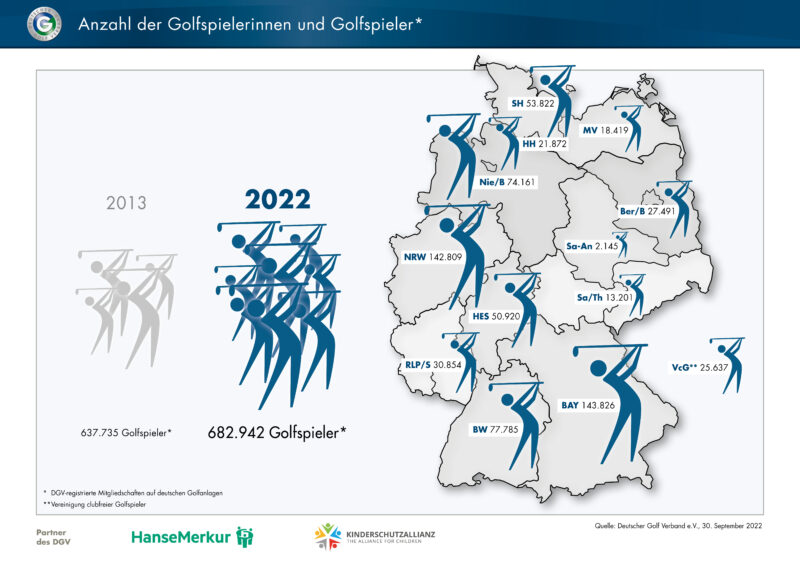
“A look at the numerical development of our twelve state golf associations shows that the NRW Golf Association has caught up and is now on a par with Bavaria at the top with 142,809 registered memberships,” says association chairman Klaus Cobold. The Baden Württemberg Golf Association is listed in third place with 77,785. The other state golf associations also recorded growth.
Development in the number of golfers (since 1951)
Golf in numbers 2021
In 2021, the number of registered golfers rose by 3.5% compared to the previous year. This corresponds to an increase of 22,566 golfers. These figures include a certain “coronavirus effect”, as many beginners took up golf during the pandemic. “This pleasing growth had already been on the cards – incidentally, it was the biggest since
2009, with an increase of 4.2 percent at the time. Golf simply offers the perfect conditions for a largely coronavirus-safe sport,” said Achim Battermann, Deputy President of the DGV.
The economic development in 2021
Membership growth is also improving the economic situation of golf courses. The number of members at 72.1% of golf clubs and golf courses increased compared to the previous year, while only 6.2% saw a decline in membership. At the same time, DGV members rated their economic situation very positively: 54.8% of golf courses rated their situation as good (15.4 percentage points compared to the previous year’s survey), 40.0% (-14.4 percentage points) as satisfactory and only 5.2% (-0.9 percentage points) as poor. Overall, almost 95% (2020: 93.8%) rated the economic situation
the economic situation of the golf course as satisfactory or good. At the same time, however, the golf clubs and facilities also observed a significant increase in costs in the areas of material costs for the course/driving range, personnel, material costs for administration and leases.
Golf in numbers 2020
Number of golfers
Golf in numbers 2019 – it remains difficult
“Stable golfer numbers are not a sure-fire success. Our European friends envy us for this situation. On average, they have lost seven percent of golfers in the last ten years, whereas we have gained 7.2 percent in the same period,” emphasizes the President of the Golf Association, Claus Kobold.
The East-West difference
| LGV | 2017 | 2018 | Difference | % |
| Saxony/Thuringia | 11.544 | 12.441 | 897 | 7,77 % |
| Rhineland-Palatinate/Saarland | 27.671 | 28.368 | 697 | 2,52 % |
| Baden-Württemberg | 74.155 | 74.497 | 342 | 0,46 % |
| Schleswig-Holstein | 48.884 | 49.102 | 218 | 0,45 % |
| Saxony-Anhalt | 1.729 | 1.862 | 133 | 7,69 % |
| Berlin/Brandenburg | 24.368 | 24.398 | 30 | 0,12 % |
| Hamburg | 21.200 | 21.108 | -92 | -0,43 % |
| Hesse | 47.992 | 47.614 | -378 | -0,79 % |
| Mecklenburg-Western Pomerania | 17.062 | 16.586 | -476 | -2,79 % |
| VcG | 22.305 | 21.821 | -484 | -2,17 % |
| Bavaria | 138.915 | 138.392 | -523 | -0,38 % |
| Lower Saxony/Bremen | 73.377 | 72.189 | -1.188 | -1,62 % |
| North Rhine-Westphalia | 135.741 | 133.862 | -1.879 | -1,38 % |
| Total | 644.943 | 642.240 | -2.703 | -042% |
Note: The VcG is the association that bundles the “club-free” golfers. When allocating the regional associations, it should be noted that the place of residence may differ from the regional association if a golfer has a long-distance membership. This is likely to be a not insignificant proportion, for example the long-distance membership provider“Start2Golf” writes that one third of all golfers in Germany have a long-distance membership.
Golf in numbers 2018 – a decline for the first time
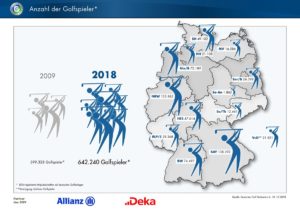
The 2018 golf summer was pretty hot. Despite the warm summer, the survey of German golf clubs showed that membership numbers increased at 37 percent of golf courses, remained the same at 38 percent and 24 percent of respondents recorded declining numbers. In a comparison of DGV-registered memberships, there was a decline of 0.4% for the first time in 2018.
644.943 registered memberships in 2017 compared to 642,240 for 2018, meaning the total number fell by 2,703. The 41 to 50 age group in particular once again lost ground. This is the first time that organized golf has recorded fewer registered memberships than in the previous year.
However, Claus M. Kobold, President of the DGV, is not concerned by this. “The number of memberships registered with the DGV is less and less an indicator of golf development as a whole. As leisure behavior changes overall, the ways in which people play golf are also changing.”
The age structure
The largest age group of golfers is once again the over-50s, who have increased significantly by more than 8,600 golfers. In terms of gender distribution, it can be seen that the proportion of female golfers has remained almost constant for years at around 36%, which is good by international standards.
| Age | male | female | Total | % |
| up to 6 years | 1.122 | 701 | 1.823 | 0,3 % |
| 7 to 14 years | 15.133 | 7.887 | 23.020 | 3,6 % |
| 15 to 18 years | 11.643 | 4.919 | 16.562 | 2,6 % |
| 19 to 20 years | 5.118 | 1.982 | 7.100 | 1,1 % |
| 21 to 26 years | 15.074 | 5.298 | 20.372 | 3,2 % |
| 27 to 35 years | 24.879 | 8.877 | 33.756 | 5,3 % |
| 36 to 40 years | 18.255 | 7.540 | 25.795 | 4,0 % |
| 41 to 50 years | 61.030 | 33.420 | 94.450 | 14,7 % |
| 51 to 55 years | 51.408 | 31.559 | 82.967 | 12,9 % |
| 56 to 60 years | 43.992 | 29.294 | 73.286 | 11,4 % |
| 61 years and older | 160.449 | 102.660 | 263.109 | 41,0 % |
| Total | 408.103 | 234.137 | 642.240 | 100,0 % |
| Percentage share | 63,5 % | 36,5 % | 100,0 % |
The breakdown of golfers by age and gender in 2018 Source: DGV
Looking at the geographical distribution of membership figures compared to the previous year, it is noticeable that the federal states in the east recorded a slight increase. In contrast, fewer members were registered in the regions with the most registered memberships, North Rhine-Westphalia, Lower Saxony/Bremen and Bavaria. The Association of Club-Free Golfers also recorded a slight decline to 21,821 memberships.
Golf in numbers 2017
The number of golfers who are members of the German Golf Association rose by 0.3% in 2017, reaching 644,943 members. This corresponds to an increase of 1,785 active players. This means that organized golf has seen little growth since records began in 1951, with lower growth only occurring in 2014 (1,102) and 2015 (1,044).
The dynamics of new members and departures correspond to those of previous years. 51.there were 293 new golfers (8.0%) compared to 49,508 people (7.7%) who are no longer at least affiliated with a German club. The growth is primarily supported by the 50 age group, which at 63.7% represents the largest proportion of golfers. When looking at the gender distribution, it can be seen that the proportion of female golfers has remained almost constant for years at around 36%, which is remarkable in an international comparison. With 731 golf courses, Germany continues to lead mainland Europe in terms of the number of club-based courses. A good overview of the figures can be found here.
Golf in numbers 2016
Golf in Germany continued to grow in 2016. With 643,158 golfers, more people were active in German golf clubs in 2016 than ever before. The figures are based on the counts of the German Golf Association. The growth of 2,977 golfers, or 0.5%, is the largest since 2012.
“The DGV members have managed to reverse the trend of declining growth and achieve the best result in four years,” said DGV President Claus M. Kobold about the 2016 golf figures. With a good 643,000 golfers, the DGV remains the eighth-largest top Olympic association in Germany.
According to a study commissioned by the DGV and the Vereinigung clubfreier Golfspieler (VcG) from the market research company REPUCOM (Nielsen Sport), the DGV’s membership survey does not cover the entire market of golfers. According to the study, 777,000 people across Germany are affiliated to golf courses in various forms. In addition, around 954,000 people who do not belong to a golf club also take up a golf club. The number of people who have already had a taste of golf is also growing steadily, rising by 1.8 million in the last six years to a total of 4.6 million.
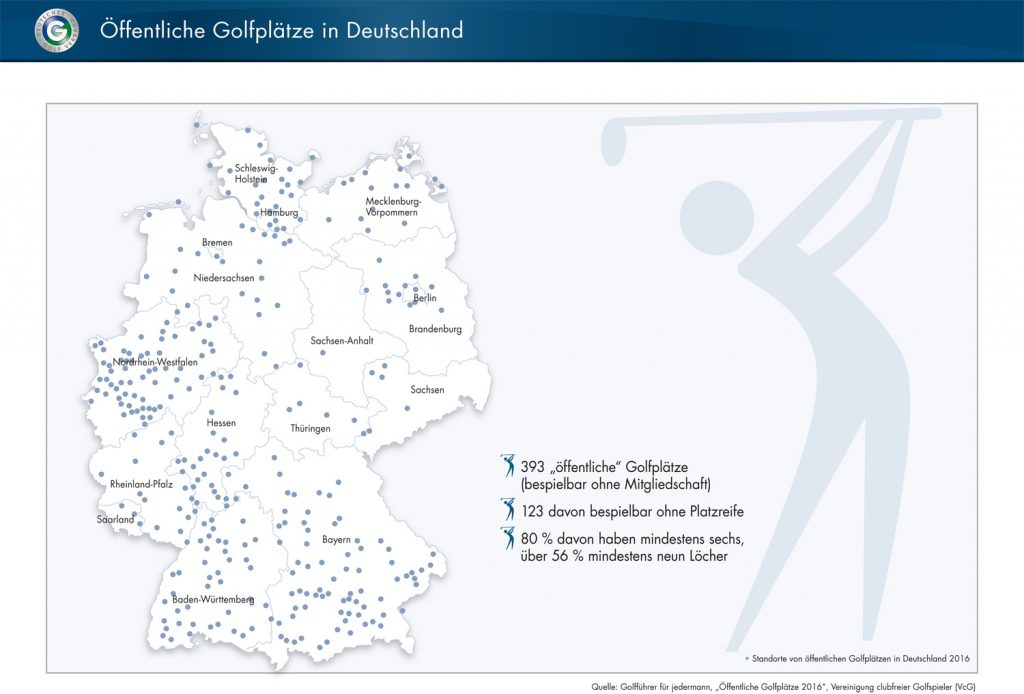
The number of DGV members and golf courses in Germany also increased last year. Twelve new members allowed the association to grow to a total of 859 full and associate members. Five new golf courses mean 732 playing opportunities nationwide.
Golf in numbers 2015
As in 2014, the number of organized golfers in Germany grew by 0.2% in 2015. In absolute figures, this corresponds to 1044 new golfers, a new low, compared to 358 more golfers in 2015. The association interprets this positively: “This is the 65th consecutive year of growth for organized golf since records began in 1951.”
The dynamics of new members and departures are great: 50,571 new golfers (7.9 percent) compared to 49,527 people (7.7 percent) who left German golf clubs.
The growth of golfers in Germany is supported in particular by the 50+ age group. While this age group grew by 2.9% in 2015, the age groups up to 26 (-2.4%) and 26 to 50 (-4.3%) recorded declines.
The golf courses
In terms of the number of golf courses, Germany remains in second place in Europe. Only England has more golf courses. With 727 golf courses, there is one less course in Germany than in the previous year, but the number of public golf courses continues to grow. According to the Vereinigung clubfreier Golfspieler (VcG), 395 golf courses are currently open to the public.
Club-free golfing
Club-free golf is growing moderately: With around 3,000 new members in 2015, the number of members of the Association of Club-Free Golfers in the DGV e.V.(VcG) rose to 23,178 at the end of the year. This corresponds to an increase of 0.7 percent. “It is very pleasing that we have succeeded in attracting around 3,000 new VcG members to organized golf despite the oversupply of easily accessible and increasingly unusual leisure and sports offers,” said VcG Managing Director Marco Paeke.
In 2014, 44% of those who left, i.e. 1,242 VcG members, found a permanent home in a golf club close to their home, which we very much welcome.” The number of resignations for 2015 has not yet been determined, as VcG members can still resign retroactively to December 31, 2015 until the end of March 2016 in order to become club golfers.
Golf in figures 2014
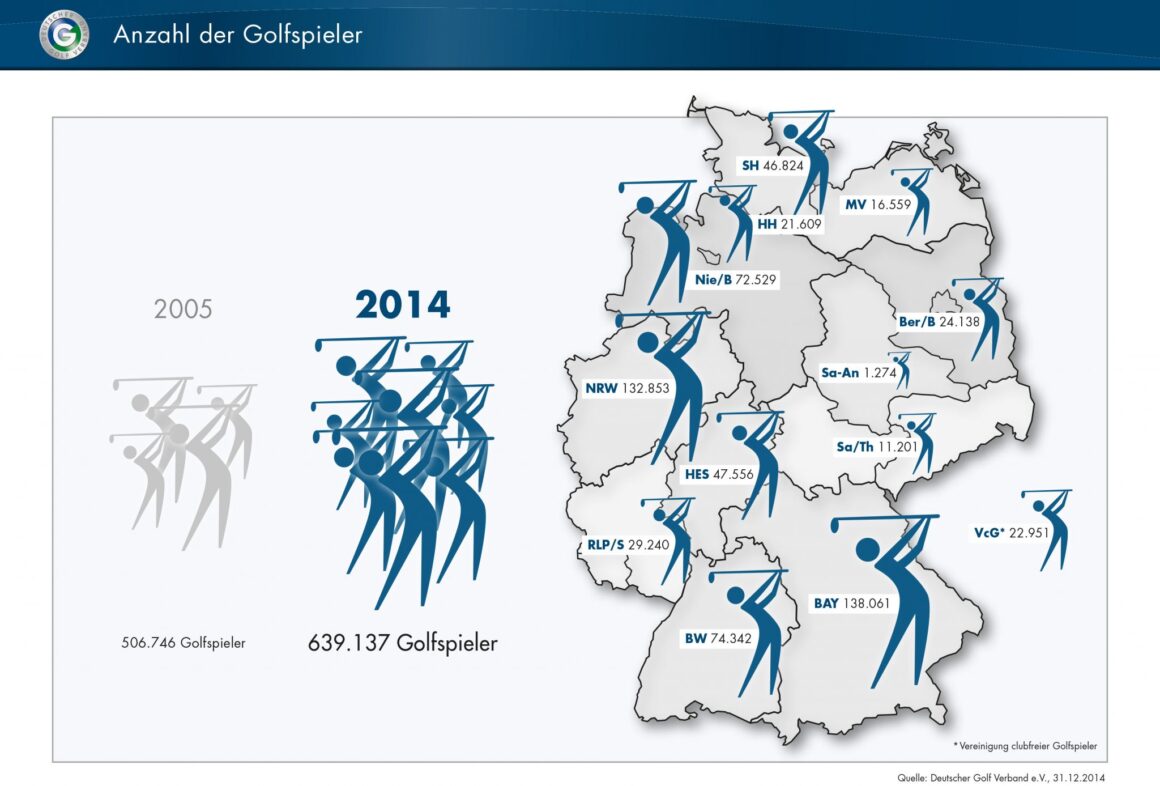
A total of 639,137 DGV members picked up a club at 728 golf courses across Germany in 2014. This means that the German Golf Association (DGV), the umbrella organization for golf clubs and golf courses, recorded growth of 0.2 percent in 2014, which corresponds to an absolute increase of 1,402 golfers.
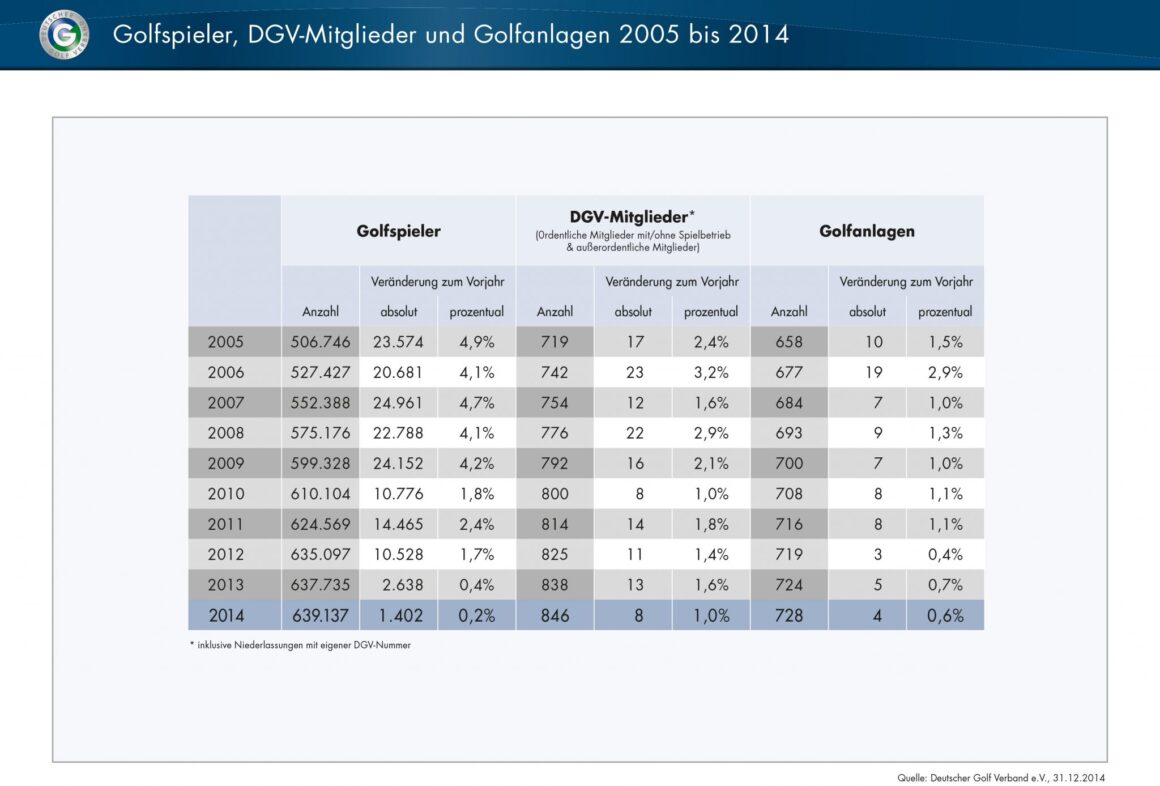
The growth of 0.2 percent represents the smallest increase since the number of golfers was recorded in 1951.
In addition to the number of golfers, the number of DGV members and golf courses in Germany has also increased. In 2014, the DGV welcomed eight new members, which corresponds to growth of 1.0% with 846 members. 665 of the DGV members are registered clubs and 195 have other legal forms. Four new golf courses increased the total number of courses in Germany to 728 (0.6%).
A regional analysis of the statistics shows that the state golf associations of Bavaria (138,061) and North Rhine-Westphalia (132,853) continue to be the federal states with the most members. They are followed by the state golf associations of Baden-Württemberg with 74,342 and Lower Saxony/Bremen with 72,529 active members.
In a national comparison with other top Olympic associations organized in the German Olympic Sports Confederation (DOSB), golf is in eighth place in terms of absolute membership numbers, as in the previous year. The DOSB figures published in the fourth quarter of 2014 relate to 2013.
Club-free golf in figures
Around 2,750 new members in 2014 – this is the balance sheet of the Vereinigung clubfreier Golfspieler im DGV e.V. (VcG). At the end of last year, Germany’s largest golf club had 23,019 active members, an increase of 0.3%.
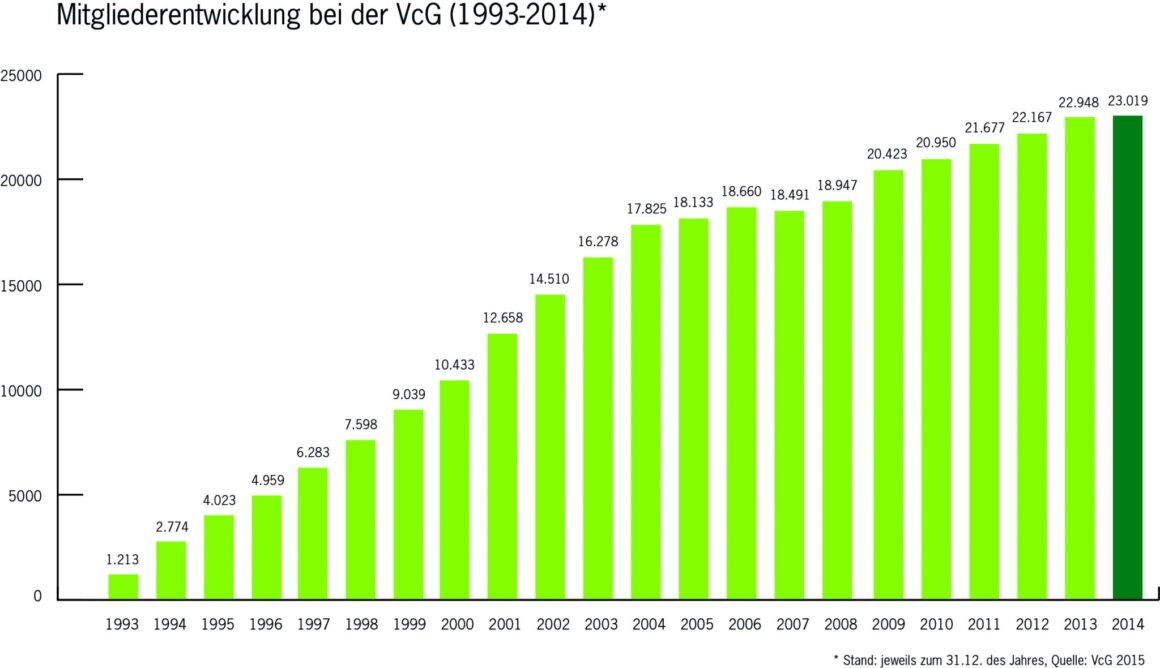
Golf in figures 2013
The number of golfers organized in the German Golf Association (DGV) reached a total of 637,735 golfers in 2013. This means that the DGV recorded slight growth of 0.4 percent in 2013, which corresponds to an absolute increase of 2,638 golfers.
The number of active golfers has been rising steadily since golf player numbers began to be recorded in 1951, albeit at a slower rate in recent years. However, growth has been declining in recent years. While the increase was 2.4 percent in 2011, it was 1.7 percent in 2012 and only 0.4 percent last year. Due to the lower growth, Nothelfer sees a need for action: “We are aware of the current situation and are therefore in close contact with the golf courses. Together with our members, we will derive measures from the current discussion on the topic of ‘golf development in Germany’ that will prepare us for future challenges.”
838 golf clubs in Germany
The number of golf clubs affiliated to the DGV increased by 13 golf courses to a total of 838 golf courses in Germany, including 657 registered clubs and 181 operators of other legal forms. Five new golf courses brought the total number of golf courses to 724 (0.7%).
A regional analysis of the statistics shows that the state golf associations of Bavaria and North Rhine-Westphalia continue to be the federal states with the largest number of members. In Bavaria, 139,547 people play golf on 172 courses, while in North Rhine-Westphalia there are 131,890 players on 159 courses. The state golf associations of Baden-Württemberg and Lower Saxony/Bremen follow with 74,340 and 73,364 active players respectively.
Compared to other top Olympic associations organized in the German Olympic Sports Confederation (DOSB), golf ranks eighth in terms of the absolute number of members. Golf ranks third behind the German Gymnastics Federation and the German Football Association in terms of the absolute growth of Olympic associations.
Golf in figures 2011
According to the German Golf Association (DGV), there are now 624,569 registered golfers in Germany, which is 14,465 more than in 2010. The number of golf courses grew by eight to 716, giving golfers a total of 12,683 holes on golf courses organized by the DGV. The DGV now has 814 members, 144 of which are operating courses.
“We are pleased that the various measures taken by the golf courses to attract new members are bearing fruit,” summarizes DGV President Hans Joachim Nothelfer.
The state golf association in Bavaria continues to have the most golfers, with 138,295 enthusiasts swinging their clubs there. This is followed, as usual, by the North Rhine-Westphalia State Golf Association with 128,903 golfers, ahead of Baden-Württemberg with 73,211 active members.
Golf in figures 2008
Growth in golf continues in 2008
At the end of 2008, a total of 575,176 golfers were organized in the 776 member clubs of the German Golf Association (DGV). This is a total of 22,788 more people than in the previous year and corresponds to growth of 4.1 percent. This confirms the long-term trend. Since 1990, annual growth has regularly exceeded the 20,000 mark. The number of golf courses has also risen again. Nine new courses were added last year, meaning that golf can now be played on 693 courses in Germany.
In terms of both the number of registered golfers and the number of golf courses, Germany ranks second in Europe behind England. “Germany has therefore also made considerable progress in a Europe-wide comparison,” says DGV President Dr. Wolfgang Scheuer. “In the last twenty years, the number of German golfers has increased fivefold.”
Bavaria remains the largest state golf association (LGV) with 130,440 registered golfers, while the LGV of North Rhine-Westphalia has 120,992 active players. Baden-Württemberg follows in third place with 68,240 golf enthusiasts.
Compared to the other 54 sports associations organized in the German Olympic Sports Confederation (DOSB), the DGV continues to perform very well. In terms of absolute new members, golf is in fourth place, just behind the German Football Association, the Alpine Club and disabled sports.
Golf in figures 2007
The German Golf Association e.V. (DGV) can once again announce increasing membership growth in its centenary year: with 552,388 registered golfers, growth of 4.7 percent was recorded for 2007, compared to 4.1 percent in the previous year. This was announced by the association today in Wiesbaden.
In total, the 748 DGV golf clubs recorded 24,961 more golfers than in the previous year. DGV President Dr. Wolfgang Scheuer is not surprised by this development: “Golf has developed consistently. In the last eleven years alone, the number of organized golfers has doubled, and even tripled in the last fifteen. The fact that growth increased in the anniversary year 2007 is a particular pleasure.”
Over 550,000 golfers played on 684 courses in 2007. That is seven courses (one percent) more than in the previous year. In percentage terms, the number of golfers has therefore once again risen faster than the number of courses. This is encouraging in terms of capacity utilization and profitability. This trend was already apparent in the last Golf Barometer in November 2007.
With 125,993 players, Bavaria remained in the lead in the state comparison. North Rhine-Westphalia was again the second largest state golf association, with 117,102 registered golfers.
Golf in figures: the half million mark will be broken in 2005
The “magic number” of half a million golfers was cracked in 2005. The German Golf Association (DGV) recorded 506,746 registered golfers in 719 golf clubs that year. Compared to 2004, this represents 23,574 new golfers, which corresponds to growth of 4.9% (previous year: 5.7%).
The then DGV President Dr. Wolfgang Scheuer said: “The constant growth in our golf community is actually nothing new. In this respect, this information hardly deserves to be called news.” At the time, Scheuer was confident and spoiled by success, not suspecting that growth would later slow down. And even then there were already signs of this: A closer look at the statistics shows that although the number of German golfers continues to grow, the absolute and relative growth per year is declining.
For years, the DGV has consistently been one of the sports with the highest number of members in the German Sports Federation. The economic trends and moods of recent years have demanded a great deal of courage and foresight from initiators and investors. The interest in new golf course projects gives us a positive outlook for the future: Ten new golf courses were added in Germany in 2005 (seven in 2004) and seventeen new clubs were formed (21 in 2004).
Bavaria leads the national comparison of state golf associations in 2005: 114,093 golfers regularly play their rounds there. However, North Rhine-Westphalia follows closely behind with 109,701 registered golfers, ahead of Baden-Württemberg (60,655).
Author: Gregor Landwehr
– DGV/VSG
– Euopean Golf Accosiation
– KPMG study on the golf market

